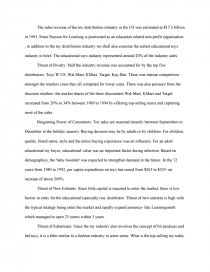Passion for Learning
Essay by Marry • July 31, 2011 • Essay • 547 Words (3 Pages) • 2,537 Views
The sales revenue of the toy distribution industry in the US was estimated at $17.3 billion in 1993. Since Passion for Learning is positioned as an education related non-profit organization , in addition to the toy distribution industry we shall also examine the subset educational toys industry in brief. The educational toys industry represented around 20% of the industry sales.
Threat of Rivalry: Half the industry revenue was accounted for by the top five distributors- Toys 'R' US, Wal-Mart, KMart, Target, Kay-Bee. There was intense competition amongst the retailers since they all competed for lower costs. There was also pressure from the discount retailers- the market shares of the three discounters Wal-Mart, KMart and Target increased from 20% to 34% between 1989 to 1994 by offering top-selling items and capturing most of the sales.
Bargaining Power of Consumers: Toy sales are seasonal (mainly between Septembers to December in the holiday season). Buying decision may be by adults or by children. For children, quality, brand name, style and the entire buying experience was an influence. For an adult educational toy buyer, educational value was an important factor during selection. Based on demographics, the 'baby boomlet' was expected to strengthen demand in the future. In the 12 years from 1980 to 1992, per capita expenditure on toys has raised from $265 to $525- an increase of about 200%.
Threat of New Entrants: Since little capital is required to enter the market, there is low barrier to entry for the educational (specialty) toy distributor. Threat of new entrants is high with the typical strategy being enter the market and rapidly expand presence- like Learningsmith which managed to open 25 stores within 3 years.
Threat of Substitutes: Since the toy industry also involves the concept of hit products and fad toys, it is a little similar to a fashion industry in some sense. What is the top-selling toy today may not be so tomorrow- it is easily substitutable. Toys tended to lose popularity quickly and new product development was therefore an important focus area for the manufacturers.
Bargaining Power of Suppliers: The suppliers in this case are the toy manufacturers. Large manufacturers like Hasbro, Mattel, Tyco entered into special arrangements with mass merchandisers like Wal-Mart and Toys 'R' Us. Under the agreement, the mass merchandisers would set up special displays and feature the toys of the large manufacturers in their promotions. These mass merchandisers were thus able to attain gross margins of 30% versus small retailers who had 70% gross margin on an average. Some independent specialty store retailers had gross margins as high as 100%. His clearly makes the mass merchandisers low cost leaders.
However, since education toys industry is a type of a specialty toy store, the relationship between smaller retailers and small specialty toy manufacturers worked well.
...
...

